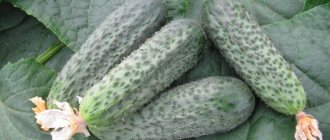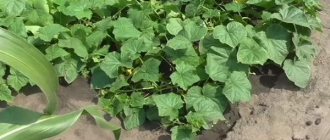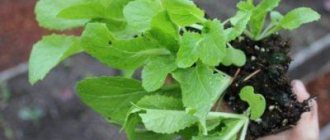Characteristic
The cucumber variety Furor was bred by agricultural breeders relatively recently, so it is not yet included in the State Register. The Furor variety has a similar description to the Bingo f1 type: the same high yield and bouquet type of flowering, parthenocarpic appearance and long-term fruiting for 1.5 months. But there is also a significant difference. The ripeness period of the Furor hybrid is ultra-early.
The fruits begin to be harvested 37-39 days after the first shoots appear. The yield is very high due to the extended fruiting of the variety. From one Furora bush, up to 7 kg of fruits are harvested per season.
The Furor variety is grown mainly in protected soil. You can plant cucumbers in an open garden bed, but in unfavorable weather conditions the variety does not produce as many fruits as in a greenhouse.
Cucumbers are consumed fresh, used in salads and vegetable dishes, and can also be preserved for the winter. The variety has excellent transportability. Cucumbers can be transported over long distances without the risk of damaging the commercial quality of the fruit.
Bushes
The bushes of the Furor variety grow in the form of a thick stem with numerous side branches and medium-density foliage. The length of the main stem can reach 3 m.
The leaves are large, five-lobed. Furor blooms with a bouquet of bright yellow, five-pointed flowers followed by the formation of ovaries. 4-5 cucumbers grow on one node.
Fruit
The fruits of the Furor cucumber variety are formed in an elongated, slightly ribbed shape. The length of ripe cucumbers is 12 cm, the diameter is 3 cm, and the average weight is 60-80 grams. The color of cucumbers is dark green, the surface with small tubercles and small spines is light in color.
The pulp inside the fruit is tender, juicy, aromatic, without bitterness. The seeds do not develop, remaining very small and almost invisible. The peel of cucumbers is very thin, but quite dense. There are no voids inside.
Description of cucumbers Furor F1
Furor cucumbers were obtained by the agricultural company Partner. The variety appeared recently, so information about it has not yet been included in the State Register. The originator has applied to register a hybrid called Furo. The final decision will be made after studying the characteristics of the variety and conducting tests.
The plant has a powerful root system. The cucumber grows quickly; in the greenhouse the main shoot reaches 3 m in length. The lateral shoots are short and well leafy.
The leaves are medium sized, with long petioles. The shape of the leaf blade is angular-heart-shaped, the color is green, the surface is slightly corrugated. The type of flowering of the Furor F1 variety is bouquet. 2 - 4 flowers appear in a node.
Pros and cons of the variety
The Furor cucumber variety has a huge number of advantages that have made it quite popular among summer residents.
pros
The advantages of the Furor variety can be described as follows:
- High productivity.
- Wonderful taste characteristics.
- Bouquet flowering and bunch formation of fruits.
- Ultra early ripening.
- Versatility of use.
- Good transportability.
- Disease resistance.
- No need for pollination by insects (parthenocarpic type).
- Long-term fruiting.
Minuses
There are few disadvantages to the Furor cucumber variety. These include only the impossibility of independently collecting seeds, since the achenes do not develop inside the fruit.
Advantages and disadvantages
Hybrid Furor has both its pros and cons. The first include:
- early and long fruiting process;
- fast growth;
- good transport tolerance;
- neat “correct” shape of the fruit;
- resistance to adverse environmental conditions;
- resistance to many diseases;
- excellent keeping quality;
- lack of bitterness in cucumbers;
- fruits do not change color if overripe;
- "pickling" character.
Disadvantages include:
- since this is a hybrid and not a variety, it will not be possible to grow Furor from collected seeds;
- if not properly cared for in open ground, the fruits may have an irregular shape;
- the price of seeds is relatively high compared to varietal cucumbers.
Landing Features
Cucumbers of the Furor f1 variety are grown mainly in greenhouses. Standard agricultural techniques are used for planting. You can sow Furor seeds directly into the soil or sow seedlings in separate cups. It is advisable to adhere to the disembarkation dates.
Landing dates
Seed material and seedlings of cucumbers of the Furor variety are planted in a permanent place of growth when the soil temperature reaches + 14-15 degrees.
Planting dates directly depend on the growing region. In southern conditions, cucumbers are planted in early April, and in colder climates - in early May.
Preparing the site in the greenhouse
The basic rule for preparing a place for planting is to create favorable conditions for the active development and growth of plants. The soil should be light, fertile, slightly acidic or neutral. It is advisable to add rotted manure, light river sand and peat from the store to the soil.
The soil has been prepared since autumn. They dig deep into the soil, remove weeds, and add all the necessary additives: river sand, peat, rotted cow manure. In the spring, dig up the soil again and disinfect it with a solution of potassium permanganate.
Before planting, it is advisable to cover the surface of the soil with non-woven material, in which slots are made for the seedlings. This event simplifies plant care, since the agrofabric retains moisture in the soil and suppresses the growth of weeds. Weeds need to be pulled out only if they appear in the holes from which cucumbers grow. Before planting, all greenhouse structures are disinfected.
Preparing the garden plot
When planting the Furor variety in open ground, the same soil preparation measures are carried out as for a greenhouse. In the garden, for cucumbers, choose a sunny, slightly shaded place with no drafts. Form beds at least 1 m wide.
Longitudinal grooves are dug on the surface of the beds, manure is poured into them, and fertile nutritious soil from the store is sprinkled on top. The rows with prepared soil are covered with plastic wrap and left to warm up for 5-6 days. Then the seeds or seedlings of cucumbers are planted.
Planting seeds
Furor cucumber seeds are covered with a special colored shell that stimulates growth. There is no need to soak, pickle or harden the seed material. They are immediately planted in the soil.
Planting seedlings
To speed up the ripening of Furor cucumbers, the seeds are sown on seedlings. Use separate cups filled with nutritious peat. When sowing seedlings, the following conditions are observed:
- air temperature + 20-23 degrees;
- soil temperature +14-15 degrees;
- penetration into the ground - 3-4 cm.
The glasses are placed in a warm, bright place. The seed germination rate of the Furor variety is 100 percent. After 3-4 days, the first shoots appear. After 3-4 weeks, seedlings that have produced 4-5 leaves can be planted in a permanent place.
Planting scheme
When planting Furor cucumbers, you must follow the standard scheme. Description of landing pattern characteristics:
- between plants – 40 cm;
- between rows – 50 cm.
No more than 4 plants are planted per 1 square meter of plot area. After planting, each bush is watered generously with warm water.
Agricultural technology
In order for the variety to form an early harvest, it must be grown in seedlings. The planting time is calculated taking into account the rapid growth of the crop; Furor seeds are sown approximately 25 days before the intended transplant. Seedlings that appear in insufficient light must be illuminated and kept at a temperature not lower than +27°C. After the appearance of side shoots, the temperature is lowered to +18°C or +23°C, watering is carried out only with warm water, you can spray it from a spray bottle. Seedlings ready for transplanting must have at least 6 true leaves. The recommended planting density is 3 - 4 pieces per 1 square meter. The soil must be nutritious, moisture- and breathable. A few days after transplantation, the bushes are tied to a trellis. At a height of 80 cm from the soil surface, all side shoots of the cucumber can be removed. On the remaining shoots, you need to preserve the ovary that appears in the axil of the first leaf, and then, after 2 or 3 leaves, limit the growth of the shoot. Care is simple - the plant needs to be provided with good watering and fertilizing. It is also necessary to carry out weeding and loosening.
Care
The cucumber variety Furor f1 needs good care, in return delighting with a high yield of tasty and high-quality fruits. Maintenance work consists of the following activities:
- Regular watering.
- Bush garter.
- Application of fertilizers.
Watering
Water cucumbers of the Furor variety once a week. Do not over-water the plant roots. During the rainy season, cucumbers should not be watered in open ground, but in a greenhouse it is necessary to reduce the frequency of watering.
In hot weather, especially during flowering, the frequency of watering is increased. Cucumber plants need to be moistened only with warm, settled water. Watering is done in the morning or evening.
Garter and bush formation
The Furor cucumber variety forms climbing bushes, therefore, to prevent the fruits from falling on the ground, the climbing vines must be tied up. For these purposes, special trellises are used to guide the growth of cucumber bushes. For tying, mesh, fishing line, and twine are used, which are tied to the greenhouse structures.
The lower leaves on cucumber bushes need to be torn off after fruiting. It is recommended to remove overgrown stepsons, as they interfere with the normal development of fruits, drawing strength from the plants.
Top dressing
Plants of the Furor cucumber variety require nutritional supplements applied at intervals of 2 times a month. To enrich the soil with useful substances, complex mineral fertilizers containing potassium, phosphorus, and nitrogen are used. You can add superphosphate, potassium nitrate, and from organic matter - mullein infusion (1:10).
Feeding cucumbers with a mixture of cow manure and potassium sulfate is useful. Description of the nutritional mixture:
- 500 gr. manure;
- 10 gr. potassium sulfate;
- 10 l. warm water.
The mixture is poured under the roots of the plants, calculating the amount of feeding: 1 bucket per 2 square meters. meters.
Hilling
Furora cucumber plants should not be hilled if the soil surface was covered with agrofibre before planting.
In open soil, it is advisable to hill up cucumber bushes by raking wet soil under the plant bushes after watering or rain and forming a ridge 4-6 cm high.
Productivity
Furor F1 is a high-yielding hybrid. Due to the tall growth and bunch type of fruiting, with proper care from 1 sq. m you can collect up to 18 kg of greens. Harvesting is carried out several times a week, but thanks to the varietal characteristics, ripe cucumbers do not outgrow or overripe. Due to its high yield, the hybrid can be grown on an industrial scale.
The variety does not require pollination, so it can be planted both in open beds and under film cover. Regardless of weather conditions and pollinating insects, the hybrid will bear fruit abundantly throughout the growing season.
Diseases and parasites
The cucumber variety Furor f1 is genetically resistant to many diseases of vegetable crops. Descriptions of diseases that can affect plants are given below.
Ascochyta blight
Cucumber plants can develop a fungal infection called ascochyta blight. The likelihood of this disease occurring increases if cucumbers are watered with cold water or if contaminated garden tools are used when caring for plants. The fungus can also be carried by air currents from another area.
Gray-black spots form on the leaves, which quickly increase in size. Next, the stem and fruits are affected. A black web appears on the shoots, causing rotting of the stems and death of the plant. Black ulcers form on the fruits. Cucumbers affected by ascochyta blight are unsuitable for food.
To prevent the disease, it is necessary to regularly ventilate the greenhouse and use equipment treated with a disinfectant.
For treatment, Bordeaux mixture is used by spraying the bushes. Use a mixture of copper sulfate and chalk (1:1), coating the stems with it.
Aphid
Cucumber bushes can be attacked by a dangerous pest - aphids. This insect forms its nests on the underside of leaves. Aphids penetrate the foliage of cucumbers and suck the juice from the plants. Borage leaves curl, dry out, and fruiting decreases. If you do not take any action, the plant will die.
To prevent infection by this parasite, it is necessary to disinfect the greenhouse and soil in spring and autumn. For treatment, bushes are treated with Fitoverm and Tanrek.
A popular way to combat aphids is to treat the bushes with mustard solution. Dry mustard powder (100 g) is dissolved in 3 liters. boiling water, stand for 3 hours. Next add 3 grams. sunflower oil, 5 tbsp. l. liquid laundry soap and pour in 10 liters. water. Spray each affected bush generously with this mixture.
Root rot
With excessive moisture, root rot may appear on cucumber plants of the Furor variety. The borage roots become thin, the stems turn yellow, and fruiting stops. The plant dies from root rot.
To prevent the development of the disease, you should water the cucumbers moderately, avoiding excessive waterlogging.
Harvesting and storage
The Furor variety is harvested in 2-3 days. It is recommended to remove cucumbers intended for pickling for the winter when they reach a size of 5-8 cm. For salads or vegetable dishes, the fruits can be grown to a size of 11-12 cm.
The Furor variety has a long shelf life. Cucumbers can be stored in the refrigerator for 2 weeks without damage.











